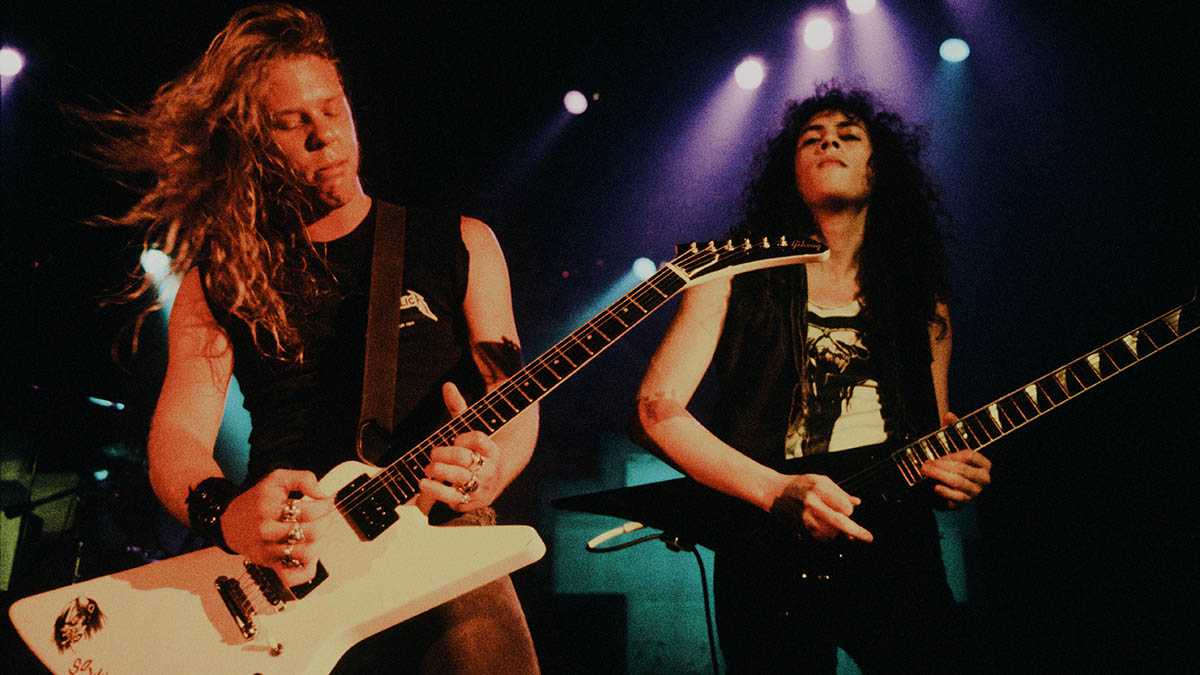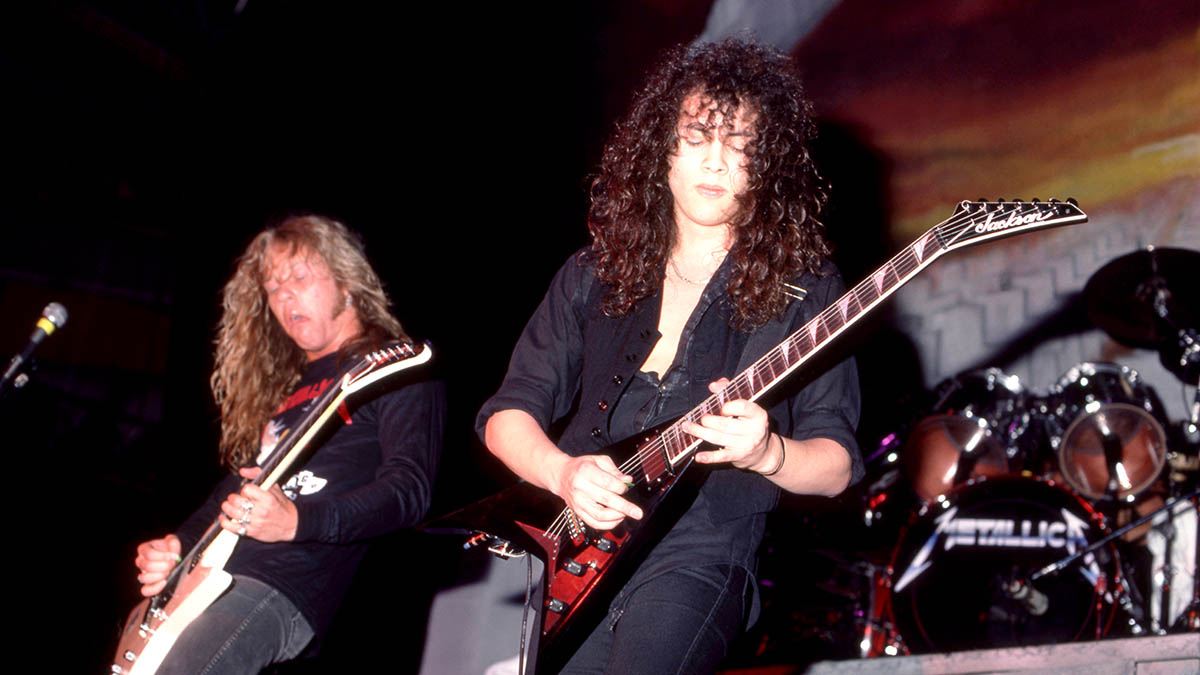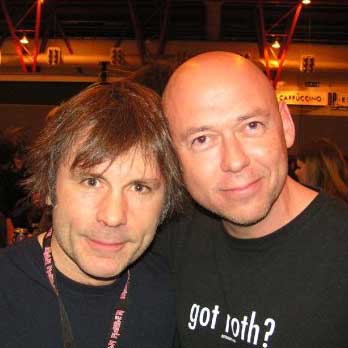How Metallica changed metal with their groundbreaking 1986 classic Master of Puppets
With testimony from James Hetfield, Kirk Hammett and producer Fleming Rasmussen, we unpack the story behind the definitive Metallica album

In early 1986, James Hetfield was in bullish mood, talking about the new Metallica album as it was being mixed at Amigo Studios in Los Angeles. “I know that on this album the fast ones are some of the fastest we’ve ever written,” he told Sounds writer Steffan Chirazi. “We’d never try to forget what Metallica formed for, no way. It’s just that maturity in style breeds better material all round.”
The album in question was Master Of Puppets, and its title track was everything that guitarist/vocalist Hetfield promised. It was fast – 220bpm at peak velocity. It had a sense of artistic maturity in its epic scope and dramatic twists and turns, playing out over eight-and-a-half-minutes through several tempo and time signature changes.
It was a guitar onslaught incorporating airtight staccato riffing, clean arpeggiated chords, harmonising twin-lead runs and a shredding, frantic solo from lead guitarist Kirk Hammett. And it would become an anthem for one of the most innovative and visionary metal bands of both the 1980s and of all time.
1986 was a landmark year for Metallica and their contemporaries from the thrash metal scene that had revolutionised heavy music in the early ’80s. It was the year of Slayer’s Reign In Blood, Megadeth’s Peace Sells... But Who’s Buying?, Dark Angel’s Darkness Descends, Kreator’s Pleasure To Kill and Destruction’s Eternal Devastation.
But in the three years since Metallica had kickstarted that revolution with their breakneck debut Kill ’Em All, they had broadened their sound and created in Master Of Puppets an album so ambitious and unique that their rivals were left playing catch-up.
During the Puppets tour, Metallica drummer Lars Ulrich told Total Guitar’s Paul Elliott: “It’s never been that pre-planned. We’ve just been following our own instincts, doing our own thing and letting it go in whatever direction feels natural. There’s never been a specific attempt to create a new sound or anything – that just happens.”
But if the initial creative spark was as instinctual as Ulrich claimed, this was music crafted with a meticulous attention to detail. In the making of Master Of Puppets, Metallica’s focus was razor-sharp. As Hetfield told Steffan Chirazi: “On a lot of numbers there are little things that demand a lot of attention. The album demands this sort of shit, man, and we know it’ll make the difference.”
Get The Pick Newsletter
All the latest guitar news, interviews, lessons, reviews, deals and more, direct to your inbox!
36 years on, Master Of Puppets is widely regarded as Metallica’s greatest album. In contemporary pop culture, the album’s title track has had a new lease of life following its front-and-centre inclusion in Netflix’s worldwide hit show Stranger Things, and in the band’s recent summer shows it has served as the grand finale.
But this monolithic track has been a pillar of the band’s live set for decades. As of September 2022, Metallica have performed Master Of Puppets live more than any other song. And with good reason. From the definitive Metallica album, it is the definitive Metallica song.
It was on September 3, 1985 that Metallica began the recording sessions for Master Of Puppets at Sweet Silence Studios in Copenhagen, Denmark, with the studio’s in-house engineer Flemming Rasmussen as their co-producer.
And all these years later, as Rasmussen speaks to Total Guitar via Zoom to discuss the creation of that album and its classic title track, he’s sitting right where it happened – in the control room at Sweet Silence, where he points behind him to the desk used for the recording. “It was a long time ago,” he says. “But I remember it all so clearly...”
Metallica had made their second album Ride The Lightning at Sweet Silence with Rasmussen at the controls back in 1984, and it was Lars Ulrich who prompted that decision. As a fan of Ritchie Blackmore, the legendary guitarist of Deep Purple and Rainbow fame, Ulrich had loved the sound of Rainbow’s 1981 album Difficult To Cure, produced by the band’s bassist Roger Glover at Sweet Silence with Rasmussen as engineer.
“Before I started working with Metallica I didn’t know anything about them,” Rasmussen admits now. “But when I listened to Kill ’Em All I heard a lot of energy, for sure. And when I met them, I loved the attitude. It was Metallica against the world in those days. You see this attitude a lot in young bands but Metallica was beyond that – they had that drive and the chemistry between the four guys.
“We talked about Kill ’Em All and they were pretty stoked with it, but they didn’t like the sound of it. But they’d heard what I’d done with Ritchie Blackmore and they all loved the sound on that. So we scrutinised the guitar sounds from Kill ’Em All and my impression was it was good but I felt we could do a lot better – which I think Ride The Lightning proved.”
There was one major problem during the recording of Ride The Lightning: Hetfield’s modified Marshall guitar amp had been stolen during a European tour. As a result, Rasmussen spoke to several Danish metal bands, including Metallica’s friends in Mercyful Fate, who brought various amps to the studio for Hetfield to try out. “We had 10 or 11 Marshall stacks set up,” Rasmussen recalls, “and James tried to figure out which of them sounded like his that was stolen.”
Ride The Lightning was a real breakthrough – a big leap forward for Metallica artistically and also commercially, selling enough to secure the band a major label deal with Elektra in the US. In the wake of that success, it made perfect sense for the band to return to Sweet Silence and continue with Rasmussen as co-producer.
All of the material for Master Of Puppets was written and complete when the band arrived at the studio. “Metallica made pretty elaborate demos,” Rasmussen says. “They worked with those cassette tapes of riffs and they’d stick the riffs together and take a part from one song and stick it into another song. So all of that was more or less done when we started on Master Of Puppets.”
For much of this album, Hetfield was playing his iconic white Gibson Explorer (the standard ceramic humbuckers were replaced with EMG 81s in 1987), but the recording of one absurdly heavy track, The Thing That Should Not Be, saw him turn to a Jackson KV1 and down-tune for the first time.
His watertight distortion was achieved not with FX – “the last time I used a distortion pedal was on Ride The Lightning,” he noted in 1992, “and it was hell!” – but from the molotov cocktail of a Mesa/Boogie Mark II C+ rewired as a preamp, and a 100-watt Marshall power amp with 4x12 cabs.
On lead, Kirk Hammett was more relaxed about effects, favouring an Ibanez Tube Screamer and a Dunlop Cry Baby, and fell back on his old axes, including a Gibson Flying V and a Fernandes Strat copy with a Floyd Rose.
Like Hetfield, Hammett was also in thrall to the fusion of Mesa and Marshall. “Boogie made those heads for a short time in the mid ’80s,” he told Guitar World. “There’s something about Boogie Mark II C heads that was really unique and very individual in their gain stages and sound. Most of Master of Puppets was tracked with Boogie heads and Marshall heads combined.”
Elaborating on the album’s amp sound, Rasmussen explains: “On this album they got the Mesa/Boogie endorsement, so they all played with five-band EQ. They got these new amps and they were all stoked, but when we tried them out, we thought, ‘..What the fuck?’ You twist the knobs and when you turn up the table you expect more top, right? But it was more or less the opposite. So we really messed around a lot with them.”

He continues: “We set up these Mesa/Boogie amps and we hooked up their new cabinets. I think we used two different cabinets on all the guitars. I used a variety of six mics on each guitar. I had two Shure SM57s right in the cone.
“I had two BMKs – they’re called DPA now, a test mic by a Danish company – I used them for room mics, so there’s one room mic on each cabinet. And on top of that I used AKG Gold tubes, in a 45-degree angle out from each cabinet, 3 or 4 feet away. So 3 mics on each cabinet, and every time we did a new part I’d fiddle with these mics till we got the right sound.”
I was always waiting to put the bass on till after the rhythm guitars, which is very important in metal music which is guitar riff-based. The bass player has to adjust to the riff the guitar is playing – not the other way round
Fleming Rasmussen
Rasmussen worked on three Metallica albums – Ride The Lightning, Master Of Puppets and 1988’s ...And Justice For All. And as he says now: “All the albums I did with Metallica were recorded on 24-track analogue tape. There’s not a computer in sight, so there’s no editing – everything is played. So we only had the 24 tracks in principle, but we used a synchroniser so we had 46 tracks available. You’d do the drums and once they were done you’d start doing the rhythm guitars.
“I was always waiting to put the bass on till after the rhythm guitars, which is very important in metal music which is guitar riff-based. The bass player has to adjust to the riff the guitar is playing – not the other way round. So we didn’t record the bass until after the rhythm guitars, which was good in the case of Cliff [Burton, Metallica bassist until his death in September 1986], because he was a player who played to what he heard.”
Metallica’s studio process was notable for Hetfield recording rhythm tracks for both himself and Hammett to ensure the intricate riffing was matched to millisecond perfection.
As Rasmussen explains: “On the albums I’ve done, James played all the rhythm guitars. Kirk doesn’t play a single rhythm guitar on Master Of Puppets. We’d set up James’s gear and Kirk’s gear and James would alternate between the stacks to do the parts.
James can strum to anything. He’s the rhythm master. He’s tight as f**k. I rate James as the best rhythm guitar player on the planet
Fleming Rasmussen
“Most of the main guitars started out on James’s Explorer and then we would swap guitars all the time. Most times we would start with James’s rhythm guitar, with two tracks in stereo, so we had the main guitar. We would then dub that on one track playing on Kirk’s equipment, which was sometimes a power amp and one Marshall pre-amp. So we had two double-tracked rhythm guitars doing James’s part, and then he would play Kirk’s part on Kirk’s guitar.”
He adds with a broad smile: “James can strum to anything. He’s the rhythm master. He’s tight as fuck. That was never a problem. I rate James as the best rhythm guitar player on the planet. He’s unbelievable.”
On recording the iconic title track, Rasmussen remembers: “There’s a lot of melodies in there, and depending on what we needed we would do six, eight, 12 tracks of melody guitars. James is playing his rhythm part, then he’s doubling his own rhythm part on Kirk’s equipment, then he plays Kirk’s parts on Kirk’s equipment and then he goes back to his own gear and double tracks Kirk’s part with his sound. So we’ve got four rhythm parts, two James and two Kirk, all played on different guitars.”
Whilst Hetfield was taking care of the track’s complicated and extremely technical rhythm parts, Hammett would be writing and perfecting his lead parts.
“Kirk would have a lot of spare time,” says Rasmussen. “They were all hanging around the studio while we were recording. It was very rare that I was there alone. There was not a lot they could do in Copenhagen in winter. So Kirk would sit in the TV room, composing his solos while we recorded rhythm guitars and drums.
“It would be me, Lars and Kirk, and [Kirk] would play the solo he’d composed. Some of the solos are really long. Lars especially had ideas of how it had to be, like, ‘We want a Ritchie Blackmore-type thing here.’ Lars has a huge knowledge of music.”
He adds: “Kirk’s solo, going from beginning to end, we would punch in. He’d do it bit by bit – so that he got the performance that he wanted and we wanted. Kirk’s a damn good guitar player.”
As for pedals, Rasmussen notes: “We tried everything we had. The setup was pretty elaborate on the Boogies. I had a studio parametric EQ inserted at the back so I could sculpt the tone in the control room. The amps were in the control room and we had the cabs out in the studio [room]. On top of what was going on on the amp I had inserted a studio EQ.”
And the distinctive twin-lead harmonies that lead the song’s middle-eight section? “Most of that was Kirk playing,” Rasmussen says. “On some of the solos we have a wah coming in and going out again, so obviously we used a wah pedal, but for distortion we probably had Tube Screamers and whatever I had lying around – Marshall boosters, all sorts of stuff. But we would boost the amps quite a bit, so a lot of the distortion would come from the amp.”
The recording of Master Of Puppets finally wrapped on Christmas Day morning, 1986. Lars Ulrich enjoyed the festive period at his family’s home near Copenhagen while Hetfield, Hammett and Burton flew back to California.
The band reunited for a gig in San Francisco on New Year’s Eve before the album was mixed in LA by Michael Wagener, the German producer who had worked on hit records for various metal bands including Motley Crue, Dokken and Accept.
Master Of Puppets was released on March 3, 1986, and went on to become Metallica’s first million seller. As Flemming Rasmussen says in conclusion: “It really is an amazing record.”
Content Editor at Total Guitar and freelance writer for Classic Rock since 2005, Paul Elliott has worked for leading music titles since 1985, including Sounds, Kerrang!, MOJO and Q. He is the author of several books including the first biography of Guns N’ Roses and autobiography of bodyguard-to-the-stars Danny Francis, and has written liner notes for classic album reissues by artists such as Def Leppard, Thin Lizzy and Kiss. He lives in Bath, UK – of which David Coverdale recently said, “How very Roman of you!”
“The main acoustic is a $100 Fender – the strings were super-old and dusty. We hate new strings!” Meet Great Grandpa, the unpredictable indie rockers making epic anthems with cheap acoustics – and recording guitars like a Queens of the Stone Age drummer
“You can almost hear the music in your head when looking at these photos”: How legendary photographer Jim Marshall captured the essence of the Grateful Dead and documented the rise of the ultimate jam band

![Metallica - CANADA - 9/12/1986 - [FULL SHOW - SBD AUDIO] - TORONTO - - YouTube](https://img.youtube.com/vi/5ESicEzUtqk/maxresdefault.jpg)
![Metallica - Live in Roskilde, Denmark (1986) [ReMaster Of Puppets DVD] - YouTube](https://img.youtube.com/vi/ohwJHplIs8E/maxresdefault.jpg)
![Metallica - Live in Nagoya, Japan (1986) [ReMaster Of Puppets DVD] - YouTube](https://img.youtube.com/vi/zxjR-V6ZeRk/maxresdefault.jpg)











